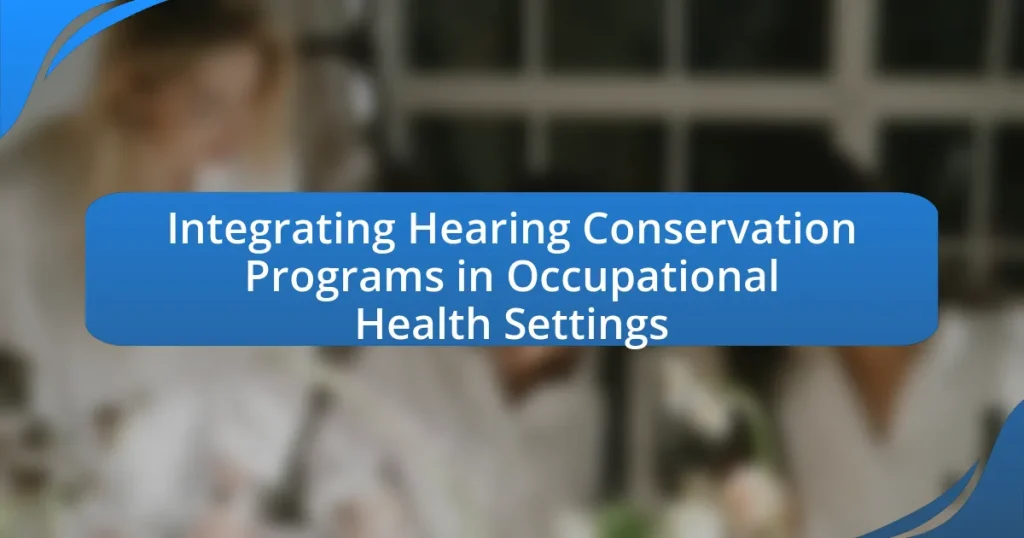Hearing Conservation Programs in Occupational Health Settings are essential initiatives aimed at preventing noise-induced hearing loss among employees exposed to hazardous noise levels. These programs encompass key components such as noise monitoring, employee training on hearing protection, regular audiometric testing, and the provision of personal protective equipment. The article outlines the importance of these programs, the risks associated with noise exposure in various industries, and the steps organizations can take to integrate effective hearing conservation strategies into their existing occupational health frameworks. Additionally, it discusses challenges in maintaining these programs and best practices for fostering a culture of hearing safety within the workplace.

What are Hearing Conservation Programs in Occupational Health Settings?
Hearing Conservation Programs in Occupational Health Settings are structured initiatives designed to prevent hearing loss among employees exposed to hazardous noise levels. These programs typically include elements such as noise monitoring, employee training on hearing protection, regular hearing assessments, and the provision of personal protective equipment like earplugs or earmuffs. According to the Occupational Safety and Health Administration (OSHA), workplaces with noise levels exceeding 85 decibels over an 8-hour time-weighted average must implement such programs to comply with safety regulations and protect workers’ auditory health.
How do Hearing Conservation Programs function within workplaces?
Hearing Conservation Programs function within workplaces by implementing a systematic approach to prevent hearing loss among employees exposed to hazardous noise levels. These programs typically include noise monitoring, employee training on hearing protection, regular hearing assessments, and the provision of personal protective equipment such as earplugs or earmuffs. According to the Occupational Safety and Health Administration (OSHA), workplaces with noise levels exceeding 85 decibels over an 8-hour time-weighted average must have a Hearing Conservation Program in place to comply with safety regulations. This structured approach not only protects employees’ hearing but also enhances overall workplace safety and productivity.
What are the key components of an effective Hearing Conservation Program?
An effective Hearing Conservation Program includes noise monitoring, employee training, hearing protection, audiometric testing, and program evaluation. Noise monitoring involves measuring sound levels in the workplace to identify areas where hearing protection is necessary. Employee training educates workers about the risks of noise exposure and the importance of hearing conservation. Hearing protection devices, such as earplugs or earmuffs, must be provided and properly fitted to employees. Audiometric testing assesses employees’ hearing ability over time to detect any changes due to noise exposure. Finally, program evaluation ensures that the Hearing Conservation Program is effective and identifies areas for improvement, which is crucial for maintaining compliance with regulations such as the Occupational Safety and Health Administration (OSHA) standards.
How do these components interact to protect employee hearing?
Hearing conservation programs protect employee hearing through a combination of engineering controls, administrative controls, and personal protective equipment (PPE). Engineering controls reduce noise exposure at the source, such as installing sound barriers or using quieter machinery, thereby minimizing the overall noise level in the workplace. Administrative controls involve implementing policies like rotating employees to limit their exposure time to high noise areas, which further decreases the risk of hearing loss. PPE, such as earplugs or earmuffs, provides a last line of defense by directly protecting employees’ ears from harmful noise levels. Together, these components create a comprehensive approach that effectively reduces the risk of noise-induced hearing loss in occupational settings.
Why are Hearing Conservation Programs essential in occupational health?
Hearing Conservation Programs are essential in occupational health because they prevent noise-induced hearing loss among workers. These programs implement strategies such as regular hearing assessments, employee training on noise hazards, and the provision of personal protective equipment, which collectively reduce the risk of hearing damage in high-noise environments. According to the Centers for Disease Control and Prevention (CDC), approximately 22 million U.S. workers are exposed to hazardous noise levels each year, highlighting the critical need for effective hearing conservation measures to protect employee health and maintain workplace productivity.
What are the potential risks of noise exposure in various industries?
The potential risks of noise exposure in various industries include hearing loss, increased stress levels, and reduced productivity. Prolonged exposure to high noise levels can lead to permanent hearing damage, with studies indicating that approximately 22 million workers in the United States are exposed to hazardous noise levels annually, resulting in significant cases of noise-induced hearing loss. Additionally, excessive noise can contribute to elevated stress and fatigue, which negatively impacts overall worker health and efficiency. The World Health Organization has reported that noise pollution can also lead to cardiovascular issues, further emphasizing the importance of addressing noise exposure in occupational health settings.
How do Hearing Conservation Programs mitigate these risks?
Hearing Conservation Programs mitigate risks associated with noise-induced hearing loss by implementing a structured approach that includes monitoring noise levels, providing hearing protection, and conducting regular hearing assessments. These programs establish permissible exposure limits and ensure that employees are educated about the dangers of excessive noise exposure. For instance, the National Institute for Occupational Safety and Health (NIOSH) recommends that employers implement engineering controls, administrative controls, and personal protective equipment to reduce noise exposure. Additionally, studies show that workplaces with effective hearing conservation strategies can reduce the incidence of hearing loss by up to 25%, demonstrating the efficacy of these programs in protecting workers’ auditory health.

What are the steps to integrate Hearing Conservation Programs into existing occupational health frameworks?
To integrate Hearing Conservation Programs into existing occupational health frameworks, organizations should follow these steps: first, conduct a comprehensive assessment of current noise exposure levels and identify at-risk employees. This assessment establishes a baseline for the program. Next, develop a written Hearing Conservation Program that outlines policies, procedures, and responsibilities, ensuring compliance with regulations such as OSHA’s Hearing Conservation Standard.
Following this, implement noise control measures to reduce exposure, which may include engineering controls, administrative controls, and personal protective equipment. Additionally, provide training and education for employees on the risks of noise exposure and the importance of hearing conservation. Regular audiometric testing should be conducted to monitor employees’ hearing health over time. Finally, establish a system for program evaluation and continuous improvement, ensuring that the Hearing Conservation Program remains effective and relevant.
These steps are supported by OSHA guidelines, which emphasize the importance of a structured approach to hearing conservation in occupational settings.
How can organizations assess their current hearing conservation needs?
Organizations can assess their current hearing conservation needs by conducting comprehensive noise exposure assessments and employee audiometric testing. Noise exposure assessments involve measuring sound levels in the workplace to identify areas where noise exceeds permissible limits, typically set by regulatory bodies such as the Occupational Safety and Health Administration (OSHA), which mandates action when noise levels exceed 85 decibels over an 8-hour time-weighted average. Employee audiometric testing, conducted annually, helps track changes in hearing ability over time, allowing organizations to identify individuals at risk of hearing loss. Additionally, organizations can review incident reports and employee feedback to identify patterns related to hearing conservation issues, ensuring that their programs are responsive to actual workplace conditions.
What tools and methods are available for assessing noise exposure levels?
Tools and methods available for assessing noise exposure levels include sound level meters, dosimeters, and noise mapping software. Sound level meters measure the intensity of sound in decibels at a specific location, providing immediate readings of noise levels. Dosimeters, worn by individuals, continuously measure personal noise exposure over time, allowing for a comprehensive assessment of an employee’s exposure during their work shift. Noise mapping software analyzes data from various sources to create visual representations of noise levels across different areas, helping to identify high-risk zones. These tools are essential for compliance with occupational safety regulations, such as those set by the Occupational Safety and Health Administration (OSHA), which mandates monitoring of noise exposure to prevent hearing loss in the workplace.
How can employee feedback be incorporated into the assessment process?
Employee feedback can be incorporated into the assessment process by systematically collecting and analyzing input from employees regarding their experiences and perceptions of hearing conservation programs. This can be achieved through surveys, focus groups, and one-on-one interviews, which allow employees to express their views on the effectiveness of the programs and suggest improvements. Research indicates that organizations that actively seek employee feedback can enhance program effectiveness; for example, a study published in the Journal of Occupational Health Psychology found that employee involvement in program design leads to higher satisfaction and compliance rates. By integrating this feedback into the assessment process, organizations can make data-driven adjustments that align with employee needs and improve overall program outcomes.
What strategies can be employed for effective program implementation?
Effective program implementation strategies for integrating hearing conservation programs in occupational health settings include establishing clear objectives, engaging stakeholders, providing training, and ensuring continuous evaluation. Clear objectives guide the program’s direction and help measure success. Engaging stakeholders, such as employees and management, fosters buy-in and support, which is crucial for program acceptance. Training ensures that all participants understand the program’s importance and procedures, enhancing compliance. Continuous evaluation allows for adjustments based on feedback and outcomes, ensuring the program remains effective and relevant. Research indicates that organizations with structured implementation strategies see a 30% increase in program effectiveness compared to those without such frameworks.
How can training and education be structured for employees?
Training and education for employees can be structured through a combination of formal instruction, hands-on practice, and ongoing assessments. This approach ensures that employees not only understand the theoretical aspects of hearing conservation but also apply them in real-world scenarios. For instance, structured programs can include workshops led by experts, interactive e-learning modules, and practical demonstrations of hearing protection equipment. Research indicates that active learning techniques, such as simulations and role-playing, enhance retention and application of knowledge, making training more effective. Additionally, regular evaluations and feedback mechanisms can help identify knowledge gaps and reinforce learning, ensuring that employees remain compliant with safety standards and best practices in hearing conservation.
What role does management play in supporting Hearing Conservation Programs?
Management plays a crucial role in supporting Hearing Conservation Programs by establishing policies, allocating resources, and fostering a culture of safety. Effective management ensures that these programs are integrated into the overall occupational health strategy, which includes regular training, monitoring of noise levels, and provision of personal protective equipment. Research indicates that organizations with strong management support for hearing conservation see a significant reduction in noise-induced hearing loss incidents, highlighting the importance of leadership commitment in achieving program effectiveness.

What are the challenges and solutions in maintaining Hearing Conservation Programs?
Maintaining Hearing Conservation Programs faces challenges such as employee non-compliance, inadequate training, and insufficient funding. Employee non-compliance often arises from a lack of awareness about the importance of hearing protection, leading to inconsistent use of protective equipment. Inadequate training can result in employees not fully understanding the risks associated with noise exposure or the proper use of hearing protection devices. Insufficient funding limits the ability to implement comprehensive programs, including regular hearing tests and educational initiatives.
Solutions to these challenges include enhancing employee engagement through awareness campaigns, providing regular and effective training sessions, and securing adequate funding through organizational support or external grants. Awareness campaigns can increase understanding of noise hazards and the importance of hearing conservation, while effective training ensures that employees are knowledgeable about the risks and the correct use of protective equipment. Additionally, organizations can advocate for budget allocations specifically for hearing conservation initiatives, ensuring that programs are sustainable and effective.
What common obstacles do organizations face in sustaining these programs?
Organizations commonly face funding limitations as a significant obstacle in sustaining hearing conservation programs. Budget constraints often lead to inadequate resources for training, equipment, and ongoing program evaluation. According to a study published in the Journal of Occupational and Environmental Medicine, nearly 60% of organizations reported insufficient funding as a barrier to effective implementation and maintenance of these programs. Additionally, lack of employee engagement and awareness can hinder program effectiveness, as employees may not prioritize hearing protection without proper education and motivation.
How can organizations overcome budgetary constraints?
Organizations can overcome budgetary constraints by prioritizing cost-effective strategies and leveraging existing resources. For instance, implementing hearing conservation programs can be achieved through partnerships with local health organizations, which may provide resources or funding. According to the National Institute for Occupational Safety and Health (NIOSH), effective hearing conservation programs can reduce costs associated with hearing loss, which can exceed $1 billion annually in the U.S. alone. By focusing on preventive measures and utilizing available community resources, organizations can effectively manage their budgets while ensuring employee health and safety.
What strategies can be used to ensure ongoing employee engagement?
To ensure ongoing employee engagement, organizations should implement regular feedback mechanisms, provide opportunities for professional development, and foster a positive workplace culture. Regular feedback allows employees to understand their performance and areas for improvement, which has been shown to increase motivation and job satisfaction. According to a Gallup study, employees who receive regular feedback are three times more likely to be engaged at work. Providing opportunities for professional development, such as training and career advancement programs, enhances employees’ skills and demonstrates the organization’s investment in their growth, leading to higher engagement levels. Additionally, fostering a positive workplace culture that promotes collaboration, recognition, and inclusivity has been linked to increased employee morale and commitment, as highlighted in research by the Society for Human Resource Management, which found that organizations with strong cultures have 30% lower turnover rates.
How can organizations measure the effectiveness of their Hearing Conservation Programs?
Organizations can measure the effectiveness of their Hearing Conservation Programs by conducting regular audiometric testing to track changes in employees’ hearing over time. This method provides quantitative data on hearing thresholds, allowing organizations to assess whether their programs are successfully preventing hearing loss. Additionally, organizations can evaluate the program’s effectiveness through employee surveys that gauge awareness and compliance with hearing protection practices. Research indicates that effective programs lead to a reduction in the incidence of noise-induced hearing loss, as evidenced by a study published in the Journal of Occupational and Environmental Medicine, which found that consistent monitoring and employee education significantly improved hearing conservation outcomes.
What metrics should be used to evaluate program success?
To evaluate the success of hearing conservation programs in occupational health settings, key metrics include hearing loss incidence rates, employee participation levels, and audiometric test results. Hearing loss incidence rates measure the frequency of new cases of hearing impairment among employees, providing insight into the program’s effectiveness in preventing hearing damage. Employee participation levels indicate engagement with training and protective measures, which are critical for program success. Audiometric test results assess changes in employees’ hearing ability over time, serving as a direct indicator of the program’s impact on auditory health. Collectively, these metrics provide a comprehensive view of program effectiveness and areas for improvement.
How can feedback loops be established for continuous improvement?
Feedback loops can be established for continuous improvement by implementing regular assessments and evaluations of hearing conservation programs. These assessments should involve collecting data on employee hearing health, program effectiveness, and compliance with safety regulations. For instance, conducting periodic audiometric testing and surveys can provide insights into the program’s impact and areas needing enhancement. Additionally, engaging employees in feedback sessions allows for the identification of challenges and suggestions for improvement, fostering a culture of continuous enhancement. Research indicates that organizations that actively solicit and incorporate employee feedback see a 14% increase in program effectiveness, demonstrating the value of these feedback loops in achieving continuous improvement in occupational health settings.
What best practices should organizations follow for successful Hearing Conservation Programs?
Organizations should implement comprehensive training, regular audiometric testing, and effective communication strategies for successful Hearing Conservation Programs. Comprehensive training ensures that employees understand the risks of noise exposure and the importance of hearing protection. Regular audiometric testing helps in early detection of hearing loss, allowing for timely interventions. Effective communication strategies, including clear signage and accessible information, reinforce the importance of hearing conservation and encourage employee participation. According to the National Institute for Occupational Safety and Health (NIOSH), these practices significantly reduce the incidence of noise-induced hearing loss in occupational settings.
How can organizations create a culture of hearing safety?
Organizations can create a culture of hearing safety by implementing comprehensive hearing conservation programs that include regular training, effective communication, and the use of protective equipment. These programs should educate employees about the risks of noise exposure and the importance of hearing protection, fostering an environment where hearing safety is prioritized. Research indicates that organizations with structured hearing conservation initiatives see a significant reduction in noise-induced hearing loss, with studies showing that effective training can increase the use of hearing protection by up to 70%. By integrating these practices into daily operations, organizations can promote a proactive approach to hearing safety, ensuring that employees are aware and engaged in protecting their hearing health.
What resources are available for ongoing education and support?
Resources available for ongoing education and support in integrating hearing conservation programs in occupational health settings include online training modules, workshops, and professional organizations. Online platforms such as the National Institute for Occupational Safety and Health (NIOSH) provide comprehensive training resources and guidelines for hearing conservation. Workshops offered by organizations like the American Speech-Language-Hearing Association (ASHA) focus on best practices and updates in hearing conservation. Additionally, professional organizations such as the American Industrial Hygiene Association (AIHA) offer networking opportunities and access to research publications that support continuous learning in this field.


